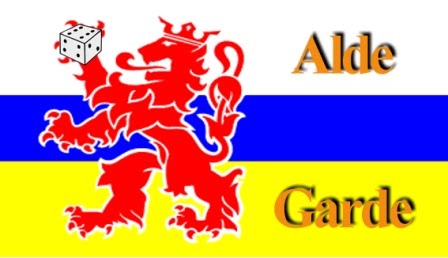On May 5th the Spring meeting of the Dutch Foundation for Model Figures (in Dutch the NSM; de Nederlandse Stichting voor Modelfiguren) took place at the "Fort aan de Buursteeg" at which place is situated the Visitors Centre for the Grebbelinie.
For those who don't know the Grebbelinie; this was one of the defense lines of the Dutch army against the invading German army in WW2.
But, although this is the most known period of the Grebbelinie, it already existed some centuries before.
The "Fort aan de Buursteeg" was build in 1786 as a defense against a possible Austrian invasion of the Seven Provinces. As that invasion never happened, the first real invasion came in 1794/1795 when French revolutionary armies crossed the frozen rivers, the allied British and Austrian armies pulled back their forces to Germany and the United Provinces came to its end in 1795 just to emerge as the Batavian Republic, a satellite state of France.
The fortress itself was never threatened by an enemy but was occupied by Dutch, British and later French troops.
The fort was in 1846 split in half as an east-west railroad was built right through the fort and effectively split the fortress in a northern and a southern part.
Underneath are some pictures of the fort whose earthen defenses were made in 1786, but these defenses were added with modern bunkers, artillery position etc just before WW2 by Dutch troops but also in the later WW2 by German troops.
Starting with a drawing of the fort which shows the situation when the railroad was made and now crossed through the fort. The top of the drawing is the facing to the east
What is to see on this moment:
Firstly there is the nice Visitors Centre of the Grebbelinie which is situated in the centre of the northern part of the fort. A picture of an earlier visit:
a picture of the northern part of the fort with the visitors centre on the left side.

A modern drawing of the fort with the railroad splitting the fort and in red the visitors centre in the northern part of the fort. The top of the drawing is North.
Some pictures fo walking through the terrain of the fort.

way up to the bastion

bastion from outside
German bunker which was camouflaged/painted as a house build at the backside of the fort. An 88mm gun was placed in the bunker. The fort was then part of the socalle "Panther stellung"

bastion from the inside
an undamaged 1940 Dutch S3 bunker

A Dutch 1940 anti tank position.
We missed it at our visit so this is from the site of the Visitors Centre whose site you can find at:
https://grebbeliniebezoekerscentrum.nl/
As said earlier, we were asked to put on a game connected to the fortress so we took our French Revolutionary miniatures and Peter built a part of the fort so our "what-if" game was connected to this great site.
So underneath are some pictures of the game.
Jan explaining the game to visitors of the centre and fort.
The fortress in Dutch hands
The wargame in full glory
advancing French

the battlefield
Part of our 1793 bakery inside the fortress
Some remarks; as peter took the pictures, sadly only Jan is visible.
Miniatures used were Eureka (French and Austrians) and Emperor Toad (Dutch). Terrain is mostly handmade by ourselves.
Rules used: Shadow of the Eagles
And thanks to the NSM for inviting us and also many thanks to the Visitors Centre for having us. It was a splended day.




.jpg)
.jpg)

























